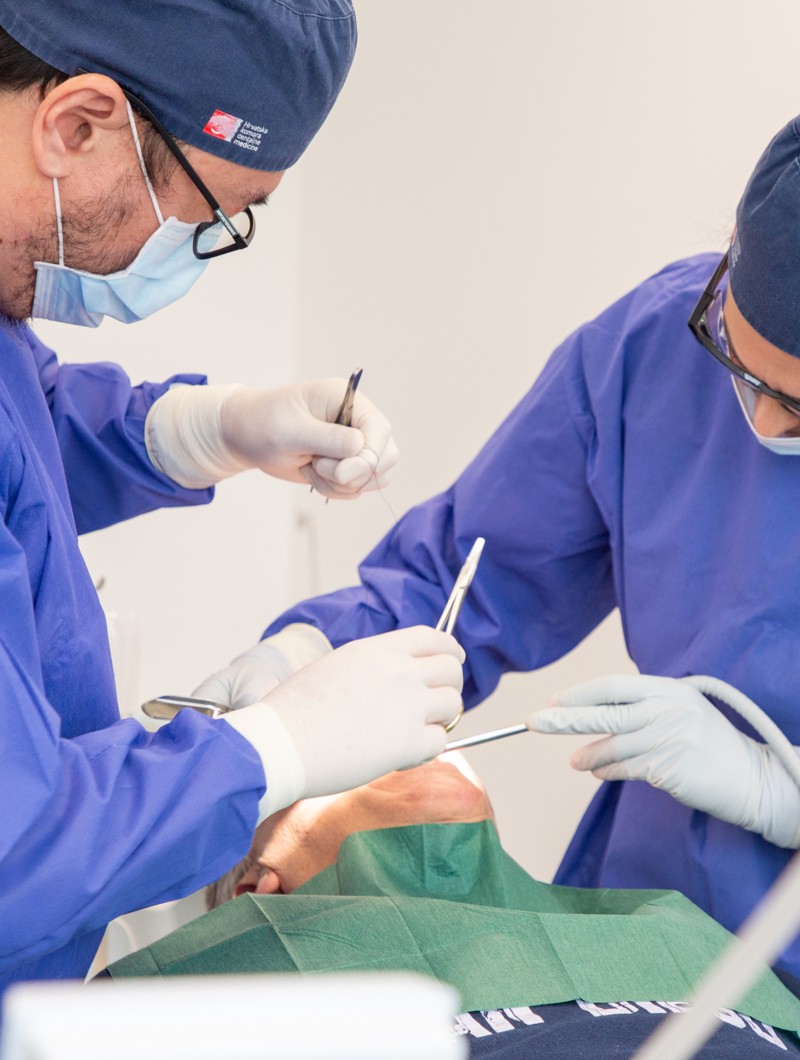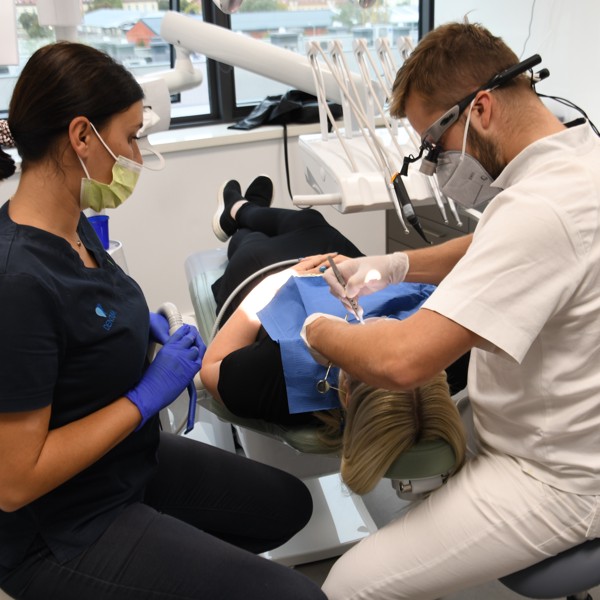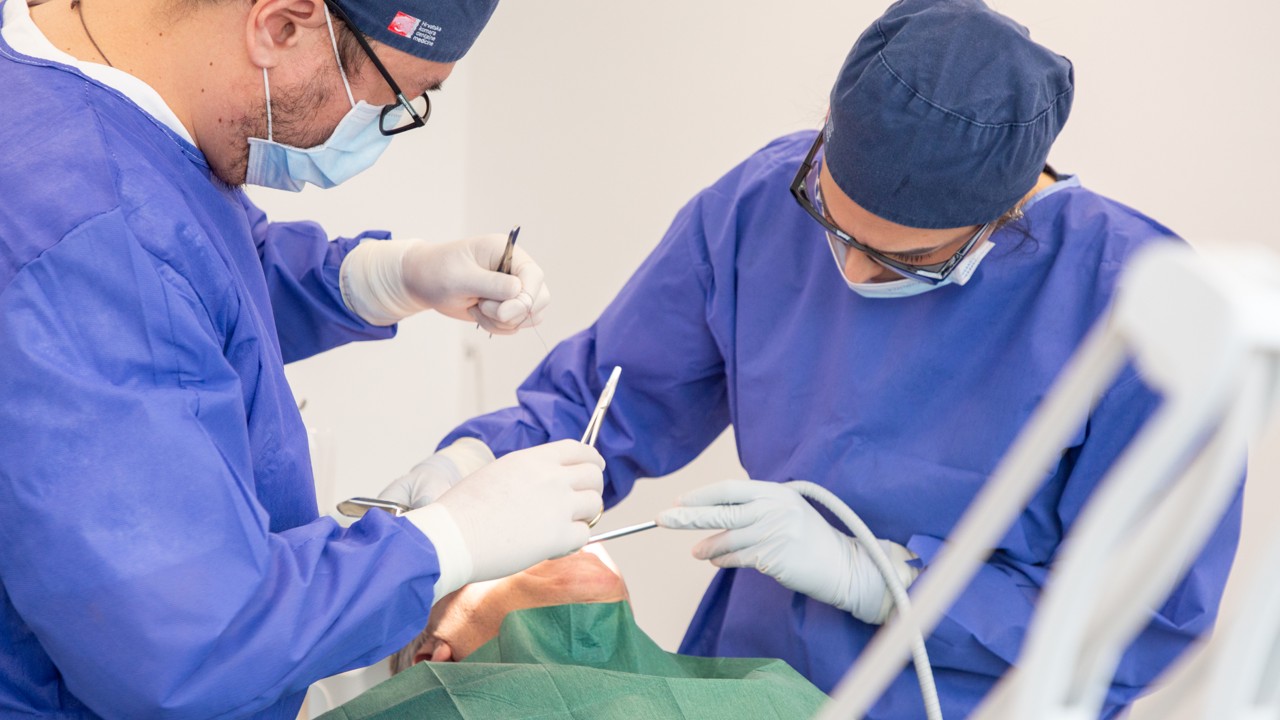Oral surgery
As a branch of dentistry, oral surgery includes various surgical procedures in the oral cavity.


What is oral surgery?
While a dentist can help you with certain dental problems, you need a specialist in oral surgery for problems with your gums, wisdom teeth, or a missing tooth. Most often, it involves the extraction of teeth and residual roots, operative or non-operative extraction of wisdom teeth, and apicoectomy, i.e., the root resection. All oral surgery procedures are performed under local anesthesia.
Who needs oral surgery procedures?
- Patients with wisdom teeth problems
- Patients with a cyst or granule in the area of the oral cavity
- Patients with insufficient bone volume for implant placement

Frequently asked questions
What is an alveolectomy?
Alveolectomy is a surgical procedure of removing wisdom teeth or residual tooth root. If extraction of the tooth or residual root by the classic method (with pliers and levers) is not possible, a surgical incision is made in the area of the jaw mucosa to reveal the bone surrounding the tooth or residual root. The oral surgeon will free the tooth or residual root so that it can be removed. The procedure is not much different from a regular tooth extraction, except that it is performed in the operating room under special conditions. The procedure is painless and takes about twenty minutes under local anesthesia. After the procedure, the mucosa is sutured with surgical thread.
What is an apicoectomy?
An apicoectomy is a procedure necessary wheb conventional root canal treatment fails to heal the inflammation around the root end. The procedure is performed under local anesthesia and requires a minimal cut in the root end. This procedure usually takes about forty minutes.
What is a cystectomy?
Cystectomy is the surgical procedure of removing a dental cyst from the oral cavity. The procedure is very similar to the procedure of apicoectomy. It is important to remove the cyst surgically, as it can affect the surrounding tissues.
What is bone augmentation?
Bone augmentation or bone grafting is a surgical procedure performed on patients with a lack of natural bone. These cases are possible due to trauma, advanced periodontitis or when, due to inflammation or other reasons, a large part of the affected bone tissue must be removed after tooth extraction. It is a routine procedure most often performed during tooth extraction or implant installation, and most patients do not even notice it. Bone grafts can be derived from donors or synthetic biocompatible materials.
What is a sinus lift?
A sinus lift is an oral surgery procedure that raises the floor of the sinus in the upper jaw to make room for bone augmentation and implant placement. The procedure is completely painless and is performed under local anesthesia.
Internal or small sinus lift is a less invasive and faster procedure performed in case of minor bone insufficiency, i.e. when 1-2 mm of bone is missing. The sinus floor is then raised to make room for the implant. This procedure is performed at the same time as the implant placement and lasts about half an hour.
External sinus lift (large sinus lift) is a more complex and time-consuming procedure that also involves the placement of artificial bone for bone insufficiency up to 4 mm, which is also the border between large and small sinus lift. If possible, it is performed simultaneously with implant placement. However, in patients with complete bone loss, we postpone the placement of implant for 6 to 8 months, until it heals. This procedure lasts up to an hour.
What is a corticotomy?
Corticotomy is a surgical procedure applied to teeth that are unable to erupt and are not visible, but they are visible on x-rays in the bone. This procedure is often used to extract impacted or retained teeth, and is often combined with orthodontic treatment to speed up the process of moving the teeth and achieving the desired position.
What is a frenulectomy?
A frenulum is a small membranous growth that connects the inner part of the oral cavity with the gums and does not cause any problems, but it can have a great impact on the position of the teeth, receding gums, speech and tongue mobility. When the frenulum is irregular, the frenulum is removed in a surgical procedure known as a frenulectomy to facilitate normal function of the lips and gums.
What is a gingivectomy?
Gingivectomy is the surgical removal of gum tissue, or gingiva, and can be used to treat conditions such as gingivitis. It is also used to remove extra gum tissue for cosmetic reasons, such as smile makeovers, as this procedure lengthens the clinical crown of the tooth.
Are all oral surgery procedures performed under anesthesia?
All oral surgery procedures in our clinic are performed under local anesthesia, regardless of whether it is tooth extraction, cyst removal or bone augmentation.
I was recommended to have a tooth extracted, do I need an oral surgeon?
Although permanent teeth should last a lifetime, unfortunately teeth are often lost, especially in old age. The most common reason for the extraction of a permanent tooth is damage for which there is no treatment that can save it.
If it is a simple tooth extraction, it is performed by a dentist, but complicated extraction procedures are performed by an oral surgeon. Before tooth extraction, the patient receives local anesthesia to make the procedure painless.
How long does recovery from alveotomy take?
After alveotomy, most patients need a few days to recover. Also, there may be some post-operative swelling and sensitivity.
How successful are artificial bone implants?
The use of synthetic biocompatible materials has been well documented in clinical trials and has excellent safety and efficacy results.

“Oral surgery includes all surgical procedures in the oral cavity, and wisdom tooth extraction (alveotomy), apicoectomy and sinus lift are the most common procedures.”
Eduardo Yoiti Isomura, DMD, maxillofacial surgeon
Oral surgery